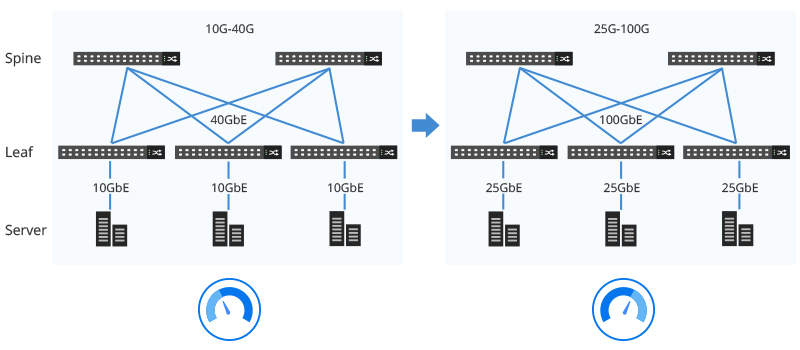Is 25GbE the New 10GbE?
As the demand for high bandwidth is soaring, 10GbE has met its bottleneck in switch-to-server connections. And 25G Ethernet is the new standard offering significant density, cost and power benefits for server to switch links. This makes 25G switch very popular in recent years. Some even said the 25G will take over 10G to become the building block of the Ethernet future. Is that possible?


25 Gigabit Ethernet: Broader Adoption Over 10GbE
Since its adoption as the industrial standard for server access connectivity in 2017, 25GbE has been in fast development and chasing a share of market against 10GbE. Though 25GbE is relatively newer compared with 10G/40G Ethernet speeds, the momentum can not be underestimated.
It was forecasted by Mellanox on 2016 Open Data Center Summit that 25G would become the mainstream network of data centers in the next three years. Today, the price of a 25G SFP28 is almost the same as a 10G SFP+. According to the recent report by IDC, though the global Ethernet switch market saw a reduction in most regions influenced by COVD-19, 25GbE switches saw impressive growth with revenues increasing and shipments growing 62.2%, which are much higher than 10GbE switches in the second quarter of 2020.
The Rise of 25GbE — Necessity of 10GbE to 25GbE Migration
The 25G technology and 25G product portfolio develop nonstop driven by the future proofing technology and applications. Let’s take a look at the main drivers of the growth of 25G and why you should follow the trend to move from 10GbE to 25GbE.
Data Center Topology Upgrade
More and more cloud computing companies like Amazon, Facebook, Google, and Microsoft have been deploying 100G Ethernet in their data centers, but the terminal devices outgrowing 10GbE capabilities. For instance, virtualization has increased server utilization, making 10GbE insufficient. More bandwidth is required as data moves down into the fabric or top of rack (ToR). A continued adoption of 25GE switches at the access between servers and ToR switches brings a solution.


The technology trends in data centers and cloud computing lead the structure upgrading, and 25G prevails over 10G at the access layer. 25G migration has boosted overall system throughput by 2.5× with small incremental costs. Moreover, 25GbE provides a simpler path to Ethernet speeds of 50 Gbps, 100 Gbps and beyond. With 25G technology maturing, end users can expect seamless operation between the main components within the datacenter network.
5G Technology
The 5G network structure consists of front-haul, middle-haul and back-haul sections which have different requirements of the transceiver modules. For instance, 25G optical transceivers comprise a large part of the front-haul infrastructure, as the granularity of the 5G front-haul network is 25Gbps. Standard 25G optical transceivers like 25GbE SFP28 SR4 and LR4 are used intensively for point-to-point direct fiber optic connection.


Moreover, 5G technology generates abundant applications. IoT technology is prevailing. Artificial intelligence is on the rise. All these make higher requirements on the network coverage and the network capacity. 25G BiDi optical transceiver with long transmission distance present as the cost-effective solution to address the issue.
Cost and Performance Optimization
Besides replacing the 10G in the access layer and serving as the pivot in the 5G front-haul, 25G also presents many more advantages no matter compared with 10G or 40G.
| Speed of port | Channel rates | Number of channels per port | Available port | Total broadband |
|---|---|---|---|---|
| 10GbE | 10 | 1 | 128 | 1280 |
| 25GbE | 25 | 1 | 128 | 3200 |
| 40GbE | 10 | 4 | 32 | 1280 |
25GbE offers the following advantages:
-
25GbE provides 2.5 times the performance of 10GbE. Since SFP28 form factor shares the same shape with SFP+, 25GbE switch provides 2.5 times the bandwidth of the 10GbE switch at the same port density.
-
25GbE offers higher bandwidth at the same power consumption of 10GbE.
-
25GbE is backford compatible with 10GbE standard and SFP28 is compatible with SFP+, thus seamless migration from 10GbE to 25GbE with consistent rack-design and reuse of the existing cabling infrastructure.
-
25GbE offers more port density than 40GbE with lower costs and power requirements.
-
The selling price of 25GbE leaf switch ports is expected to drop at the price of 10GbE.
In the future, data centers, wireless networks, access networks and transmission networks will form a cooperative demand for 25G optical transceivers, rising to the breaking point for newer demands. With a modest cost and better performance characteristics and the background of data center upgrading and 5G technology, there is no reason to use 10GbE any more. It is promising that 25G will become the new 10G.
Are You Ready for 25GbE?
With the promising trend, network equipment providers and network owners are all taking actions. FS has been continually introducing 25GbE product portfolios. FS 25GbE switches, 25GbE SFP28 transceiver modules, ConnectX SmartNICs and cables deliver comprehensive and high performance solutions. Server-to-ToR switch connections in data centers are upgraded from 10GbE to 25GbE. Some far-sighted enterprises have deployed 10GbE switches with 25GbE uplinks for future-proof upgrading. It is only a matter of time that 25GbE will replace 10GbE and become the mainstream of Ethernet.
You might be interested in
Email Address

-
PoE vs PoE+ vs PoE++ Switch: How to Choose?
Mar 16, 2023














